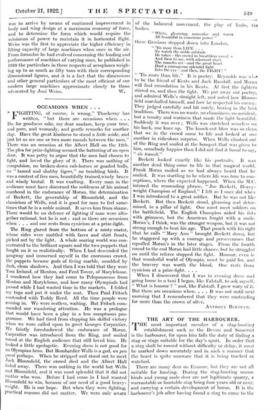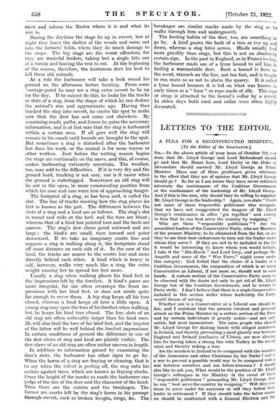THE ART OF THE HARBOURER.
THE most important member of a stag-hunting establishment such as the Devon and Somerset is the harbourer, for upon him falls the duty of finding a stag or stags suitable for the day's sport. In order that a stag shall be roused without difficulty or delay, it must be marked down accurately and in. such a manner that the beast is quite unaware that it is being tracked or watched.
There are many deer on Exmoor, but they arc not all suitable for hunting. During the stag-hunting season hinds and young male deer are not legitimate quarry, a warrantable or huntable stag being four years old or over, and carrying a certain development of horns. It is the harbourer's job after having found a stag to come to the -meet and inform the Master where it is and what its size is.
During the daytime the stags lie up in covert, but at night they leave the shelter of the woods and come out into the farmers' fields, where they do much damage to the crops. The big stags are the worst offenders, for they are wasteful feeders, taking but a single bite out of a turnip and leaving the rest to rot. At the beginning of the season, therefore, the huntsman 'does his best to kill these old animals.
As a rule the harbourer will take a look round his ground on the afternoon before hunting. From some • 'vantage-point he may see a stag enter covert -to lie up • for the day. If he cannot do this, he looks for the tracks or slots of a -stag, from the shape of -which he can deduce the animal's size and approximate age. Having thus - tracked the stag into covert, he circles the spot to make sure that the deer has not come out elsewhere. By examining roads, -paths, and fences he gains the necessary information, and is at last sure that the stag is harboured within a certain area. If all goes well the stag will remain in his couch until -hounds are brought to the spot.
• But sometimes a stag is disturbed after the harbourer has done his work, or the anima 'is for some reason or other restless. Just before the rutting season begins the stags are continually on the move, and this, of course, makes harbouring extremely uncertain. The weather, too, may add-to th-e difficulties. If it is very dry and the ground hard, tracking is not easy, nor is it easier when the ground is waterlogged. Sometimes an old stag will lie out in the open, in some commanding position from which his nose and ears warn him of approaching danger.
The footprint of a stag, as has been said, is called the slot. The line of tracks showing how the stag places his feet is known -as the gait. The differences between the ' slots of a stag and a hind are as follows. The stag's slot is round and wide at 'the heel, and 'the toes are blunt ; whereas that of a hind has pointed toes and the heels are narrow. The -stag's dew claws point outward and are large ; the hind's are small, turn inward and point downward. if we -take an imaginary centre line and suppose a stag is -walking along it, the footprints stand off some distance on each side of it. In the case of the hind, the tracks are nearer to -the centre line and more directly behind each other. A hind which is heavy in calf, however, walks very much like a -stag, the extra -weight causing her to spread her feet more.
Usually a stag when walking places 'his hind feet in the impressions-left by the forefeet. A hind's paces are more irregular, for she- often oversteps the front im- pressions with her hind feet, or does not stride quite far enough to cover them. A big stag keeps all his toes closed, whereas a hind keeps all hers a little open. A young stag may open the toes of his forefeet when walking, but he keeps his hind toes closed. The fore slots of an old stag are often noticeably larger than his hind ones. He will also trail the toes of his hind feet, and the imprint -of the latter will be well behind the forefeet impressions. In certain conditions of ground the difference in size of - the dew claws of stag and hind are plainly visible. The -dewclaws of an old stag are often rather uneven in length.
In addition to information gained by examining the deer's slots, the harbourer has other signs to go by. When the horns of a stag are fraying or cleaning, that is to say when the velvet is peeling off, the stag rubs his antlers against frees, which are known as fraying stocks. From the height of the marks so made the harbourer can -judge of the size of the deer and the character of the head. Then there are the entries -and the breakages. The former are marks left by the stag's horns in his passage *hrou211 covert. such as broken boughs, twigs, &c. The breakages are similar marks -made by the stag as he walks 'through -fern and undergrowth.
The feeding "habits 'of the -deer, too, are something to go by. A hind gnaws the bark -of a -tree or ivy up and 'down, -whereas -a stag bites -across. Hinds usually feed more greedily than 'stags, but this is -not an absolutely certain -sign. In the past in 'England, as in France to-day, the harbourer made use of a lyme hound to -aid him in finding a warrantable deer. Sudh -a hound is keen on the scent, stauneh on the -line, not too fast, and is -taught to run mute so as not to alarm the -quarry. It is called a lyme hound because it is led on what was known in early times as a " ham " or rope made of silk. This rope or strap is attached to the hound's collar by a swivel, In olden days both cord and collar - were often highly decorated.



































































 Previous page
Previous page